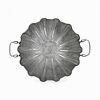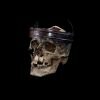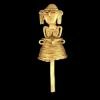
In 2000 a group of walkers found Roman pottery and animal bones on a hill in East Leicestershire. Using a metal detector, retired teacher Ken Wallace subsequently unearthed vast numbers of Iron Age coins.
After the find was reported, local archaeologists explored the site. They found more than twelve hoards of gold and silver coins, preserved in burial pits. Most were struck by the Corieltauvi, an Iron Age tribe occupying the area about 2000 years ago. Others are of the Iron Age king Cunobelin, known as 'Britannorum Rex' (King of the Britons). There are also early Roman coins from mainland Europe.
The archaeologists also found the remains of a Roman cavalryman's helmet. This and the Roman coins show that the people using the site had links with the Classical world. The helmet may have been a gift or could have belonged to a Roman soldier killed in battle.
Some of the animal bones are complete and were probably sacrificial offerings. Others have cut-marks, the signs of feasting. Archaeologists now believe the hill was a ritual meeting place where people made offerings to their gods and held great feasts.
Previously, many thought the East Midlands was not important in the British Iron Age. Ken Wallace and the other members of the fieldwalking group have changed this view.









